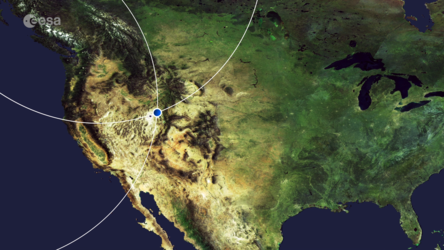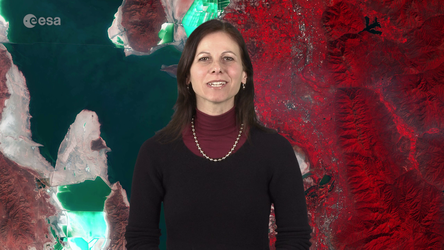Accept all cookies Accept only essential cookies See our Cookie Notice

About ESA
The European Space Agency (ESA) is Europe’s gateway to space. Its mission is to shape the development of Europe’s space capability and ensure that investment in space continues to deliver benefits to the citizens of Europe and the world.
Highlights
ESA - United space in Europe
This is ESA ESA facts Member States & Cooperating States Funding Director General Top management For Member State Delegations European vision European Space Policy ESA & EU Space Councils Responsibility & Sustainability Annual Report Calendar of meetings Corporate newsEstablishments & sites
ESA Headquarters ESA ESTEC ESA ESOC ESA ESRIN ESA EAC ESA ESAC Europe's Spaceport ESA ESEC ESA ECSAT Brussels Office Washington OfficeWorking with ESA
Business with ESA ESA Commercialisation Gateway Law at ESA Careers Cyber resilience at ESA IT at ESA Newsroom Partnerships Merchandising Licence Education Open Space Innovation Platform Integrity and Reporting Administrative Tribunal Health and SafetyMore about ESA
History ESA Historical Archives Exhibitions Publications Art & Culture ESA Merchandise Kids Diversity ESA Brand Centre ESA ChampionsLatest
Space in Member States
Find out more about space activities in our 23 Member States, and understand how ESA works together with their national agencies, institutions and organisations.
Science & Exploration
Exploring our Solar System and unlocking the secrets of the Universe
Go to topicAstronauts
Missions
Juice Euclid Webb Solar Orbiter BepiColombo Gaia ExoMars Cheops Exoplanet missions More missionsActivities
International Space Station Orion service module Gateway Concordia Caves & Pangaea BenefitsLatest
Space Safety
Protecting life and infrastructure on Earth and in orbit
Go to topicAsteroids
Asteroids and Planetary Defence Asteroid danger explained Flyeye telescope: asteroid detection Hera mission: asteroid deflection Near-Earth Object Coordination CentreSpace junk
About space debris Space debris by the numbers Space Environment Report In space refuelling, refurbishing and removingSafety from space
Clean Space ecodesign Zero Debris Technologies Space for Earth Supporting Sustainable DevelopmentLatest
Applications
Using space to benefit citizens and meet future challenges on Earth
Go to topicObserving the Earth
Observing the Earth Future EO Copernicus Meteorology Space for our climate Satellite missionsCommercialisation
ESA Commercialisation Gateway Open Space Innovation Platform Business Incubation ESA Space SolutionsLatest
Enabling & Support
Making space accessible and developing the technologies for the future
Go to topicBuilding missions
Space Engineering and Technology Test centre Laboratories Concurrent Design Facility Preparing for the future Shaping the Future Discovery and Preparation Advanced Concepts TeamSpace transportation
Space Transportation Ariane Vega Space Rider Future space transportation Boost! Europe's Spaceport Launches from Europe's Spaceport from 2012Latest

Puzzle of Utah
Thank you for liking
You have already liked this page, you can only like it once!
In this false colour image from 20 August, Sentinel-2A brings us to Utah’s Salt Lake City and surroundings.
Utah’s capital in the United States, Salt Lake City, sits at 1300 m, bordered by the waters of the Great Salt Lake and the peaks of the Wasatch Range, which rise over 1.6 km above the Salt Lake valley floor.
The Great Salt Lake, partly visible on the left side of the image, is the largest salt-water lake in the Western Hemisphere. Owing to its shallowness, its size shifts substantially. The lighter blue areas denote solar evaporation ponds at the edges of the lake, which produce salts and brine.
The lake contributes an estimated $1.3 billion annually to Utah's economy, comprising the harvesting of brine shrimp, industry in mineral extraction, and recreation.
Although it has been referred to as "America's Dead Sea”, the lake provides habitat for millions of native birds, brine shrimp, shorebirds and waterfowl.
In 1904, the Southern Pacific Causeway was built to create a shorter route across the lake, visible across the top part. This acts as a dam, where the northern end of the lake became more saline than the southern end.
To appreciate this better, we can compare the natural colour composite of the same area. Using this band combination the variations in the water are more evident, however, the drawback is that we lose the efficiency of the infrared band in monitoring vegetation.
The mountains and several parks appear in varying shades of red, owing to this false-colour band combination. This indicates how sensitive the multispectral instrument on Sentinel-2A is to differences in chlorophyll content, providing key information on vegetation health.
The scattered greys and whites visible along the centre of the image are the City of Salt Lake, home to some 190 000 people and to important mining operations in its surroundings, which produce copper, gold, platinum, silver, lead, and zinc among others, along with various salts from the lake.
This image is also featured on the Earth from Space video programme.
-
CREDIT
Copernicus Sentinel data (2015)/ESA -
LICENCE
CC BY-SA 3.0 IGO or ESA Standard Licence
(content can be used under either licence)

Utah's Great Salt Lake

Uintah Basin, United States

Salt Lake, Utah

Earth from Space: Utah’s Great Salt Lake















 Germany
Germany
 Austria
Austria
 Belgium
Belgium
 Denmark
Denmark
 Spain
Spain
 Estonia
Estonia
 Finland
Finland
 France
France
 Greece
Greece
 Hungary
Hungary
 Ireland
Ireland
 Italy
Italy
 Luxembourg
Luxembourg
 Norway
Norway
 The Netherlands
The Netherlands
 Poland
Poland
 Portugal
Portugal
 Czechia
Czechia
 Romania
Romania
 United Kingdom
United Kingdom
 Slovenia
Slovenia
 Sweden
Sweden
 Switzerland
Switzerland
























